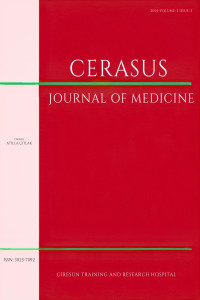Abstract
References
- Kellie FJ. Medical methods for preventing blood loss at caesarean section. Cochrane Database of Systematic Reviews. 2018; Availablefrom: http://dx.doi.org/10.1002/14651858.cd007576.pub22.
- Wang HY, Hong SK, Duan Y, Yin HM. Tranexamic acid and blood loss during and after cesarean section: a meta-analysis. J Perinatol. 2015;35(10):818-825. doi:10.1038/jp.2015.93
- Doumouchtsis SK, Nikolopoulos K, Talaulikar V, Krishna A, Arulkumaran S. Menstrual and fertility outcomes following the surgical management of postpartum haemorrhage: a systematic review. BJOG. 2014;121(4):382-388. doi:10.1111/1471-0528.12546
- Liu WM, Wang PH, Tang WL, Wang IT, Tzeng CR. Uterine artery ligation for treatment of pregnant women with uterine leiomyomas who are undergoing cesarean section. Fertil Steril. 2006;86(2):423-428. doi:10.1016/j.fertnstert.2006.01.027
- Joshi VM, Otiv SR, Majumder R, Nikam YA, Shrivastava M. Internal iliac artery ligation for arresting postpartum haemorrhage. BJOG. 2007;114(3):356-361. doi:10.1111/j.1471-0528.2006.01235.x
- Allam MS, B-Lynch C. The B-Lynch and other uterine compression suture techniques. Int J Gynaecol Obstet. 2005;89(3):236-241. doi:10.1016/j.ijgo.2005.02.014
- Cowan AD, Miller ES, Grobman WA. Subsequent pregnancy outcome after B-lynch suture placement. Obstet Gynecol. 2014;124(3):558-561. doi:10.1097/AOG.0000000000000418
- Sentilhes L, Gromez A, Razzouk K, Resch B, Verspyck E, Marpeau L. B-Lynch suture for massive persistent postpartum hemorrhage following stepwise uterine devascularization. Acta Obstet Gynecol Scand. 2008;87(10):1020-1026. doi:10.1080/00016340802380750
- Setiyono, A. B., Aziz, A., Sulistyono, A., &Mose, J. C. (2015). Pereira Suture: an alternative compression suture to treat uterine atony. Indonesian Journal of Obstetrics and Gynecology, 177-18.
- Ghezzi F, Cromi A, Uccella S, Raio L, Bolis P, Surbek D. The Hayman technique: a simple method to treat postpartum haemorrhage. BJOG. 2007;114(3):362-365. doi:10.1111/j.1471-0528.2006.01204.x
- Cho JH, Jun HS, Lee CN. Hemostatic suturing technique for uterine bleeding during cesarean delivery. Obstet Gynecol. 2000;96(1):129-131. doi:10.1016/s0029-7844(00)00852-8
- Matsubara S, Yano H, Taneichi A, Suzuki M. Uterine compression suture against impending recurrence of uterine inversion immediately after laparotomy repositioning. J Obstet Gynaecol Res. 2009;35(4):819-823. doi:10.1111/j.1447-0756.2008.01011.x
- Sulistyono, A.D., Gultom, E.S., Dachlan, E.G., & Prabowo, P. (2011). Conservative Surgical Management of Postpartum Hemorrhage (PPH) Using ’Surabaya Method’ (Modified B-Lynch Compression Suture). Indonesian Journal of Obstetrics and Gynecology, 34, 108-113.
- Forna F, Miles AM, Jamieson DJ. Emergency peripartum hysterectomy: a comparison of cesarean and postpartum hysterectomy. Am J Obstet Gynecol. 2004;190(5):1440-1444. doi:10.1016/j.ajog.2004.02.021
- Winata, I. G. S., & Asmara, A. D. (2022). Abdominal Packing for Obstetric Surgical Uncontrollable Hemorrhage. European Journal of Medical and Health Sciences, 4(4), 70–74. https://doi.org/10.24018/ejmed.2022.4.4.1446
Abstract
Over the past five decades, there has been a substantial global increase in cesarean section rates. Unfortunately, the incidence of maternal morbidity following cesarean delivery remains notably high, reaching levels as elevated as 36%. Among the prevalent complications are febrile episodes (25%), hemorrhage (4%), hematoma formation (4%), and urinary tract infections (3%). Obstetric hemorrhage, in particular, stands out as a leading cause of maternal mortality worldwide. Excessive bleeding, defined as a blood loss exceeding 1000 ml during cesarean sections, is frequently underestimated, yet it is documented in over 5-10% of such procedures. While conservative management, including vaginal packing and the administration of uterotonic agents, is effective in many instances, persistent hemorrhage may necessitate specific surgical interventions. Therefore, a comprehensive understanding of the procedural steps for managing bleeding during cesarean sections is crucial to mitigating maternal mortality. This review article aims to consolidate various techniques employed to control hemorrhage during cesarean deliveries.
Keywords
References
- Kellie FJ. Medical methods for preventing blood loss at caesarean section. Cochrane Database of Systematic Reviews. 2018; Availablefrom: http://dx.doi.org/10.1002/14651858.cd007576.pub22.
- Wang HY, Hong SK, Duan Y, Yin HM. Tranexamic acid and blood loss during and after cesarean section: a meta-analysis. J Perinatol. 2015;35(10):818-825. doi:10.1038/jp.2015.93
- Doumouchtsis SK, Nikolopoulos K, Talaulikar V, Krishna A, Arulkumaran S. Menstrual and fertility outcomes following the surgical management of postpartum haemorrhage: a systematic review. BJOG. 2014;121(4):382-388. doi:10.1111/1471-0528.12546
- Liu WM, Wang PH, Tang WL, Wang IT, Tzeng CR. Uterine artery ligation for treatment of pregnant women with uterine leiomyomas who are undergoing cesarean section. Fertil Steril. 2006;86(2):423-428. doi:10.1016/j.fertnstert.2006.01.027
- Joshi VM, Otiv SR, Majumder R, Nikam YA, Shrivastava M. Internal iliac artery ligation for arresting postpartum haemorrhage. BJOG. 2007;114(3):356-361. doi:10.1111/j.1471-0528.2006.01235.x
- Allam MS, B-Lynch C. The B-Lynch and other uterine compression suture techniques. Int J Gynaecol Obstet. 2005;89(3):236-241. doi:10.1016/j.ijgo.2005.02.014
- Cowan AD, Miller ES, Grobman WA. Subsequent pregnancy outcome after B-lynch suture placement. Obstet Gynecol. 2014;124(3):558-561. doi:10.1097/AOG.0000000000000418
- Sentilhes L, Gromez A, Razzouk K, Resch B, Verspyck E, Marpeau L. B-Lynch suture for massive persistent postpartum hemorrhage following stepwise uterine devascularization. Acta Obstet Gynecol Scand. 2008;87(10):1020-1026. doi:10.1080/00016340802380750
- Setiyono, A. B., Aziz, A., Sulistyono, A., &Mose, J. C. (2015). Pereira Suture: an alternative compression suture to treat uterine atony. Indonesian Journal of Obstetrics and Gynecology, 177-18.
- Ghezzi F, Cromi A, Uccella S, Raio L, Bolis P, Surbek D. The Hayman technique: a simple method to treat postpartum haemorrhage. BJOG. 2007;114(3):362-365. doi:10.1111/j.1471-0528.2006.01204.x
- Cho JH, Jun HS, Lee CN. Hemostatic suturing technique for uterine bleeding during cesarean delivery. Obstet Gynecol. 2000;96(1):129-131. doi:10.1016/s0029-7844(00)00852-8
- Matsubara S, Yano H, Taneichi A, Suzuki M. Uterine compression suture against impending recurrence of uterine inversion immediately after laparotomy repositioning. J Obstet Gynaecol Res. 2009;35(4):819-823. doi:10.1111/j.1447-0756.2008.01011.x
- Sulistyono, A.D., Gultom, E.S., Dachlan, E.G., & Prabowo, P. (2011). Conservative Surgical Management of Postpartum Hemorrhage (PPH) Using ’Surabaya Method’ (Modified B-Lynch Compression Suture). Indonesian Journal of Obstetrics and Gynecology, 34, 108-113.
- Forna F, Miles AM, Jamieson DJ. Emergency peripartum hysterectomy: a comparison of cesarean and postpartum hysterectomy. Am J Obstet Gynecol. 2004;190(5):1440-1444. doi:10.1016/j.ajog.2004.02.021
- Winata, I. G. S., & Asmara, A. D. (2022). Abdominal Packing for Obstetric Surgical Uncontrollable Hemorrhage. European Journal of Medical and Health Sciences, 4(4), 70–74. https://doi.org/10.24018/ejmed.2022.4.4.1446
Details
| Primary Language | English |
|---|---|
| Subjects | Clinical Sciences (Other) |
| Journal Section | Reviews |
| Authors | |
| Publication Date | June 30, 2025 |
| Submission Date | September 3, 2024 |
| Acceptance Date | November 3, 2024 |
| Published in Issue | Year 2025 Volume: 2 Issue: 2 |


